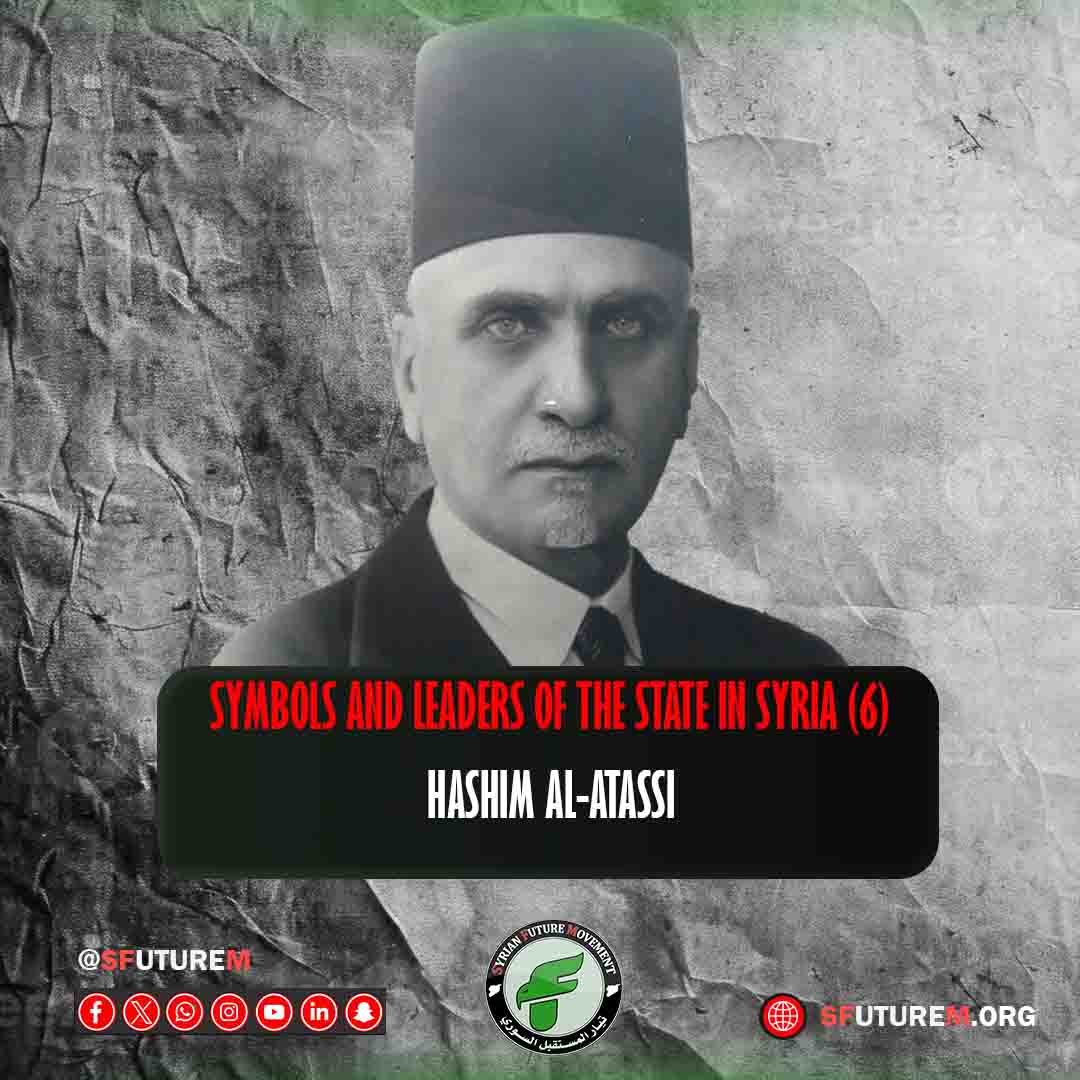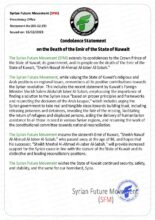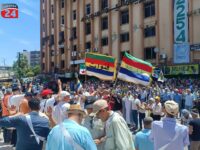Symbols and Figures of the State in Syria (6): Hashim al-Atassi

- Hashim al-Atassi was born on December 6, 1875, into one of the most famous and wealthy feudal families of Homs, which had been politically active since the Ottoman era.
- He received his primary and secondary education in Homs and then moved to Istanbul, where he studied public administration at the Royal Academy, graduating in 1895.
- His political career began in the Ottoman Empire in 1898 when he was appointed a prominent official in the Ottoman province of Beirut.
- During World War I in 1914, he was appointed governor of Homs, Hama, Baalbek, Jaffa, and Anatolia.
- Al-Atassi supported nationalists demanding independence from the Ottoman Empire and was elected a member of the Syrian General Congress, the first Syrian parliament, representing the four regions of Greater Syria in June 1919.
- He was elected President of the Congress on March 8, 1920, where the Arab Kingdom of Syria was declared, and Faisal I was unanimously chosen as its king.
- Al-Atassi chaired the committee drafting the kingdom’s constitution, which was approved in June 1920.
- After the fall of the kingdom following the resignation of the second Al-Rikabi government, King Faisal I tasked Al-Atassi with forming the government, which he did on May 2, 1920, making him the second person to serve as Prime Minister of Syria.
- The government accepted the famous Gouraud ultimatum on June 13 and declared a state of emergency on June 15. On June 20, it dissolved the Syrian army as part of complying with the ultimatum, leading to protests and riots in Damascus and other cities, including the occupation of Damascus Citadel by protesters.
- His government used live ammunition, resulting in the deaths of twenty demonstrators.
- General Henri Gouraud, the commander of French forces in the Levant, claimed he had not received the government’s acceptance of the ultimatum, so he marched to Damascus from Beirut on July 21 and met the remnants of the Syrian army and volunteers in the Battle of Maysalun on July 24.
- Al-Atassi appointed Abdul Rahman Shahbandar, who had close ties with European politicians, to form alliances with the West and try to prevent the French mandate over Syria, but to no avail.
- The French entered Damascus on July 25, and the government, along with the king, moved to Kiswa and resigned on the same day as a result of the Battle of Maysalun and the occupation of Damascus. A pro-mandate government was formed under Alaa al-Din al-Droubi, and three days later, King Faisal was exiled, ending the Syrian Kingdom after Al-Atassi had presided over it for about three months.
- During the Great Syrian Revolt, al-Atassi refused to participate as it was an armed rebellion. He believed that independence comes as a result of the victory of justice, not violence.
- In October 1927, al-Atassi met with several prominent activists known for their opposition to the French mandate over Syria, including Shukri al-Quwatli, Saadallah al-Jabiri, and Fares al-Khoury, among others. They announced the formation of the “National Bloc,” which played a prominent role in Syrian political life until 1963.
- He formed several individual governments during both the mandate and independence periods.
- The formation of the National Bloc was a response to the People’s Party, known for its loyalty to the French, headed by Abdul Rahman Shahbandar.
- The National Bloc was founded as a response to the suppression of the Great Syrian Revolt that began in 1925 and was quashed by the French in August 1927. Al-Atassi and his colleagues in the National Bloc believed that Syria could achieve independence and unity through peaceful means rather than violent resistance.
- Hashim al-Atassi was elected president of the National Bloc and a permanent member of its office.
- The National Bloc founded by al-Atassi included feudal lords, lawyers, employees, students, and all segments of Syrian society.
- Al-Atassi worked to extend the activities of the national movement beyond the “Syrian state” declared by the French in Damascus and Aleppo in 1925, to include Latakia, Sweida, and other areas.
- After negotiations between Taj al-Din al-Hasani and French Commissioner Henry Ponsot, which led to elections for a constituent assembly to draft a constitution for the country in 1928, al-Atassi chaired this assembly.
- The constitution drafted by al-Atassi stipulated a republican parliamentary system.
- During the protests in Syria in 1930, in response to the non-publication of the constitution and the call for parliamentary elections, the French arrested al-Atassi for several months and transferred him to the island of Arwad.
- When the French called for parliamentary elections in Syria in 1932, the National Bloc won seventeen seats, including al-Atassi.
- On December 21, 1935, the National Bloc organized a memorial service on the occasion of the fortieth day after the death of Ibrahim Hanano at the Syrian University Auditorium. During the ceremony, Fares al-Khoury announced the “National Pact,” which was followed by bloody strikes and security disturbances. President Muhammad Ali al-Abed and his government, led by Sheikh Taj, failed to suppress them. Following these protests, the offices of the National Bloc in Damascus and Aleppo were closed, and several of its leaders, such as Saadallah al-Jabiri, were arrested. In response, the people organized a general strike in Damascus and other cities that lasted sixty days. The French army had to deploy in the main streets of the cities and Commissioner de Martel threatened to bomb Damascus as had happened in 1925. Iraq, Lebanon, Jordan, Palestine, and Egypt witnessed demonstrations supporting the Syrian people, along with support from Britain. As a result of international pressure, the French Commissioner agreed to meet with Hashim al-Atassi, president of the National Bloc, and agreed with him to form a new government and a Syrian delegation to travel to France to negotiate a new treaty guaranteeing Syrian rights.
- As a result of the agreement, al-Hasani’s government resigned, and the fourth and last government of the al-Abed era, led by Ata al-Ayyoubi, was formed on February 23, 1936.
- About a month later, on March 21, the National Bloc delegation, headed by al-Atassi, left for France. The negotiations lasted six months until September, when the agreement between the delegation and the French government was announced on September 9, and the draft agreement was published on October 22, to be signed before the end of the year.
- In early October, the national delegation returned from Paris by train to Aleppo, where they were received with a massive popular welcome organized by the National Bloc office, with the participation of Commissioner de Martel, who described the treaty as the “miracle of the twentieth century.”
- Al-Abed called for parliamentary elections, the second in Syrian history, which the Bloc won by a landslide.
- One of the direct results of the agreement between the Bloc and France was the reintegration of the State of the Alawite Mountain and the State of Jabal al-Druze with the motherland on December 5, 1936, while retaining administrative and financial independence.
- The parliament of the State of the Alawite Mountain announced that Latakia was relinquishing its financial and administrative independence to be “equal to other Syrian provinces,” and Midhat Pasha, a key member of the National Bloc, was appointed governor of Latakia.
- The new parliament opened its sessions on December 21, 1935, and on the same day, al-Abed resigned.
- In the session where al-Abed’s resignation was accepted, Hashim al-Atassi was elected president, and the first government was formed under the leadership of Jamil Mardam, comprising major figures from the National Bloc.
- Al-Atassi resigned on May 7, 1939, stating in his resignation speech that France continued to procrastinate regarding Syrian independence and the withdrawal of all French troops, in addition to the declaration of Hatay as an independent state in 1938, followed by the withdrawal of French troops and the entry of Turkish troops in 1939.
- Al-Atassi returned to Homs and refused to participate in political activities, announcing his retirement.
- Charles de Gaulle visited him in Homs and invited him to reconsider his resignation, confirming that France intended to fully recognize Syrian independence after the end of the war, but al-Atassi refused.
- In 1941, Taj al-Din al-Hasani was appointed president, the constitutional life was restored, and parliamentary elections were held in 1943, which the National Bloc won again. Al-Atassi supported Shukri al-Quwatli, one of the leaders of Damascus, for the presidency, thus becoming known as both a president and a kingmaker. It was agreed that al-Atassi would remain president of the National Bloc and al-Quwatli would be president of the republic.
- During the government crisis in 1947, al-Quwatli offered al-Atassi the position of prime minister to lead a national unity government. Al-Atassi agreed on the condition that, if he accepted, the powers of the president, which had been increasing contrary to the conditions of a parliamentary republic, would be limited. However, al-Quwatli refused.
- In March 1949, al-Quwatli was overthrown by Army Chief of Staff Husni al-Za’im in the first military coup in the Middle East. Al-Za’im led a military government for four months before being overthrown in another military coup in August 1949, led by Sami al-Hinnawi, who invited al-Atassi to come out of retirement and form a provisional government to oversee elections that would restore civilian rule.
- Al-Atassi complied with al-Hinnawi’s request and included a national unity government with all parties.
- During his presidency, a new electoral law was drafted, allowing women to vote for the first time on November 15-16, 1949.
- A Constituent Assembly was formed, and al-Atassi was elected its president. He was then nominated for a second term as president of the country.
- Al-Atassi was elected president for the second time by unanimous vote in December 1949.
- He allied with the People’s Party and appointed its leader, Nazim al-Qudsi, as prime minister.
- During his term, negotiations for unity with Iraq were opened.
- His second term saw the closure of the border with Lebanon under the pretext of preventing the influx of Lebanese goods that were flooding the Syrian market.
- After traveling to Baghdad and meeting its king, Faisal II, opposition arose from Adib al-Shishakli, one of the prominent army leaders, who warned al-Atassi of the consequences of Baghdad taking over Damascus. However, al-Atassi refused to bow to military pressures. Consequently, al-Shishakli staged a coup in December 1949, arrested Sami al-Hinnawi and prominent sympathizers of the People’s Party, along with several army officers loyal to Iraq.
- In the period between the 1949 coup and the 1951 coup, al-Atassi accepted al-Shishakli’s conditions. For complex reasons, al-Shishakli staged another coup in 1951, arresting the prime minister, all members of the People’s Party, and all ministers and state officials supporting the Hashemite family, then dissolved the parliament.
- In protest, al-Atassi submitted his resignation to the dissolved parliament on December 24, 1951, refusing to present it to al-Shishakli, considering his rule unconstitutional.
- Throughout Adib al-Shishakli’s rule from 1951 to 1954, al-Atassi led covert opposition against him, asserting that his rule was unconstitutional.
- A national uprising started in Aleppo, followed by a coup in 1954 between February 24-26. Adnan, al-Shishakli’s son, was arrested. In response, al-Shishakli placed al-Atassi under house arrest but did not imprison him, respecting his prominent role in Syrian political life.
- On March 1, al-Atassi returned from Homs to Damascus and resumed his duties as president. He reinstated the cabinet and its head, Maarouf al-Dawalibi, as well as all ambassadors, ministers, and parliamentarians dismissed by al-Shishakli from their previous positions.
- During his second term, al-Atassi tried his utmost to eliminate all traces of al-Shishakli’s four-year rule.
- Al-Atassi spent his final years in office, at the age of eighty, fighting the influence of army officers and striving to limit the growing influence of leftist parties in the country, alongside socialism and sympathy with the Soviet Union, as well as Gamal Abdel Nasser, supported by some of the al-Atassi family members like Jamal al-Atassi and Nour al-Din al-Atassi.
- During his tenure, al-Atassi managed to keep Syria neutral and outside the socialist camp.
- In 1955, al-Atassi leaned towards accepting the Baghdad Pact, an agreement backed by the United States and Britain aimed at containing Soviet influence in the region, but Nasserite officers in the Syrian army prevented him from doing so.
- During the conflict between Hashemite Iraq and Egypt’s Abdel Nasser, al-Atassi sided with Iraq and allied with Nuri al-Said.
- After dismissing al-Asali, al-Atassi appointed Fares al-Khoury as prime minister.
- Al-Atassi sent his prime minister, al-Khoury, to Egypt to protest the Egyptian government’s dominance over Arab affairs.
- Al-Atassi’s term ended in September 1955, and he retired from political life, returning to Homs where he resided in his home.
- His son, Adnan al-Atassi, was convicted of collaborating with Iraq to stage a military coup to overthrow Shukri al-Quwatli, who was loyal to Abdel Nasser. Adnan was sentenced to death for high treason, but out of respect for his father, the sentence was commuted to life imprisonment.
- The officers who ran the military court issued harsh sentences in retaliation against al-Atassi, particularly because he had curbed the military’s power during his second and third terms. Nevertheless, he refused to visit his son in prison.
- He died in Homs on December 6, 1960, during the years of the United Arab Republic. His funeral was the largest in the city’s history, attended by Gamal Abdel Nasser alongside senior state officials.
- His vision of the United Arab Republic was realized when it dissolved in 1961, three months after his death.
- Al-Atassi was a man of peaceful principles and constitutional methods, with respect for all players in Syrian politics.
- President Hashim al-Atassi is one of the few from the pre-Ba’ath political class in Syria whose legacy was not criticized or tarnished by the Ba’athists after they came to power in 1963.
- His biography was published in Syria in 2005 by his grandson.
In the Syrian Future Movement (SFM), as we remember the anniversary of the founding fathers of Syria, we recall one of Syria’s influential figures and one of the prominent symbols of the first Syrian state who contributed to shaping its structure. He is the father of the republic and the advocate of the peaceful constitutional approach, His Excellency President Hashim al-Atassi.
In a sequential file that we present to you, which includes the symbols and figures of the Syrian state, we aim to connect our contemporary revolutionary present with a strong past and historical milestones. We hope to revive in our people the need to build and create distinguished statesmen, learning from their experiences and building on their history, to preserve the nation, safeguard achievements, and restore the honor and glory of the Syrian state after years of oppression, tyranny, and corruption.






